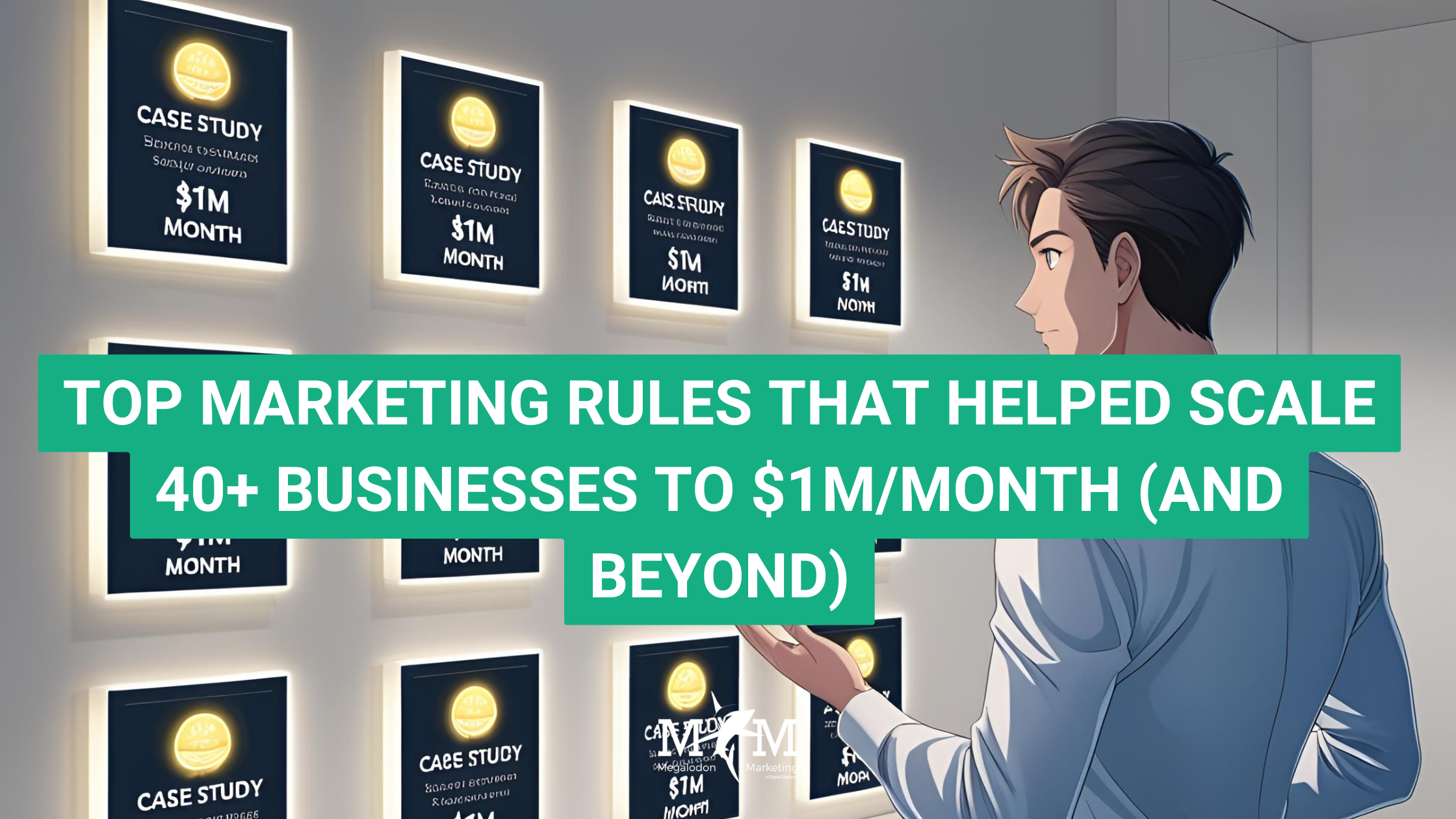I hope you enjoy reading this blog post. If you want my team to just do your marketing for you, click here.

I hope you enjoy reading this blog post. If you want my team to just do your marketing for you, click here.
Author: Jeremy Haynes | founder of Megalodon Marketing.

Earnings Disclaimer: You have a .1% probability of hitting million dollar months according to the US Bureau of Labor Statistics. As stated by law, we can not and do not make any guarantees about your own ability to get results or earn any money with our ideas, information, programs or strategies. We don’t know you and, besides, your results in life are up to you. We’re here to help by giving you our greatest strategies to move you forward, faster. However, nothing on this page or any of our websites or emails is a promise or guarantee of future earnings. Any financial numbers referenced here, or on any of our sites or emails, are simply estimates or projections or past results, and should not be considered exact, actual or as a promise of potential earnings – all numbers are illustrative only.
Watch the full video breakdown on this topic here.
If you’re reading this, you’ve probably realized there’s a gigantic chasm between “small spend marketing” and “big spend marketing.” Spending, say, $100 a day on ads comes with a certain comfort level. Perhaps you get some leads, a few sales, and you optimize your ads at a leisurely pace. There’s little panic because the stakes are low.
But the moment you scale that to $3,000, $5,000, or even $10,000+ per day, everything speeds up—just like jumping from casual city driving to pushing 100+ miles per hour in a performance car. The environment changes. The data changes. Your entire approach must rise to the occasion, or you’ll crash. You must develop a high-speed mindset.
I’ve personally guided more than 40 different businesses to million-dollar months—often well beyond that—by helping them either directly manage their marketing teams or providing strategic consultation. From small agencies that once juggled a few thousand dollars per month to top-tier entrepreneurs spending hundreds of thousands of dollars per month, I’ve seen what works and what fails.
Let’s dive into the real lessons—the proven strategies, the stories from my experience, and the mental frameworks that separate the capable, high-level marketer from the pack of wannabe “media buyers.” I call them rules to live by when you’re spending a fuckload of money on ads.
One of the most critical mental shifts you need to make is detaching your ego from always being “right.” This concept might seem trivial at first, but wait until you see how many marketers sabotage campaigns because they cling to what they want to work, instead of what actually works.
That’s a quote I’ve repeated more times than I can count. Let’s say you have a tool stack—maybe you’ve always used Typeform integrated with Cly to schedule calls, and historically, you got great results. Then someone on your team or another marketer in a mastermind shares data showing that Typeform plus ScheduleOnce is actually delivering leads at 30% cheaper cost. The rookie mistake is to refuse switching, because you’re used to your beloved old system.
At the higher tiers of marketing, you look at your data, see that the new approach is cheaper and equally (or more) qualified, and you pivot on the spot. This is how you keep your CPAs as low as possible when you’re spending massive sums. I can’t stress enough: your job is not to stand by your personal favorites—your job is to put money in the bank.
I’ll give you another real example. I often share a content retargeting approach called “hammer them,” which involves saturating new leads with a barrage of short, engaging videos. I once deployed it with a partner’s account, and initially, it was a huge win. Show rates went up, lead quality went up, cost per acquisition even dropped.
Six months in, we noticed the old problems resurfacing: leads were coming into calls unprepared, asking “basic” questions that the short-form content was supposed to have addressed. Did we stand by the short-form content strategy as if it was infallible? Absolutely not. We started adding long-form videos to the mix. Full podcasts, deeper interviews, event replays—anything that would give prospects enough context before that call. Instantly, we saw the leads’ sophistication jump again.
The key is never assuming you’ve found a permanent solution. The market changes, platforms evolve, or your audience’s attention span shifts. The moment you see data suggesting something else is outperforming your old way, you pivot for maximum profitability.
Here’s a problem I see constantly when teams go from spending, say, $10,000 per month in ads to $50,000, $100,000, or even $500,000+ per month. There’s a subgroup of marketers who do a lot of “busy” work. They run around telling you how many hours they’ve poured in, or how they “worked all weekend” on a new campaign. Yet if you probe into the results, the leads or the revenue, you might find they’ve barely moved the needle.
Let’s be crystal clear: at scale, nobody cares if you’ve labored 60 hours per week. If your new landing page split test flops, or if your retargeting funnel fails to improve your show rate, or if your ad campaign yields a subpar ROAS, it simply doesn’t matter how many nights you stayed awake polishing an ad set. When you’re playing with major money, results are the only currency that matters.
A related concept is the difference between someone who calls themselves a “media buyer” and a marketer. A “media buyer” typically focuses on one narrow part of the process: plugging images, copy, and targeting into an ad manager. They disclaim responsibility for everything else. For instance, if show rates tank or if the back end of the funnel collapses, they shrug and say, “That’s not my department.”
By contrast, a professional marketer takes a broader view. They:
In other words, the true marketer’s domain doesn’t end the moment the ad is live. They see the entire marketing and sales process as their playground, looking for inefficiencies or friction points that need to be fixed. And guess what: that is what you must be doing if you want million-dollar months. Because the moment you scale, friction in any stage of your funnel gets amplified, and if you don’t catch it quickly, the budget you’re pouring in is wasted.
I once advised a client going from $200k months to over $1 million per month. The marketing team had the same guy in charge of everything from the beginning. At $200k a month, it was manageable: a handful of campaigns, a comfortable testing pace, no intense daily cost ramifications if something failed. But with $1 million a month in revenue—and a big chunk of that going back into ads—every misstep cost thousands. The “employee mindset” approach of trying to do a million little tasks, measuring success by hours, was a recipe for stalling out. They needed results-driven analysis. They needed someone to track every single micro-conversion from impression to sale. Once that shift happened, and the team started focusing on raw outcomes—cost per lead, cost per acquisition, show rate, close rate—growth got back on track.
People often ask, “How do I identify what part of my funnel to fix first when I have so many variables—my ad creative, my webinar, my page load times, etc.?” The short answer is: you break everything down into data points, then see which metric is hurting you the most relative to your benchmarks or your desired targets.
Let’s use a “call funnel” example. Typical metrics might include:
When you map these, you can clearly see which metric is furthest from an acceptable range, or which one is the easiest to improve. Fixing it might double your total profit because it cascades through the entire funnel.
I always coach my clients to look at each metric and ask, “Which is the easiest to double?” Suppose your unique CTR is only 0.5%. Jumping to 1% is rarely some Herculean feat if you optimize your ad copy, call-to-action, or creative. That one fix effectively pumps double the traffic downstream, potentially yielding double the customers—all while spending the same daily budget.
If your funnel’s bigger hole is the show rate—say it’s 30%—you might try a combination of confirmation page optimization, email reminders, text reminders, or what I call “hammer them” content retargeting. That could bring you to a 50% or 60% show rate. Look at what that alone might do for your revenue.
In a high-spend environment, the Doubling Game is like going from 10 mph to 70 mph in marketing velocity. Each step you improve has an exponential effect on your results because the scale magnifies every percentage gain.
Picture a high-ticket service business offering $10,000, $15,000, or even $50,000 packages. For a long time, the show rates for their webinars and calls are in the healthy 70–80% range. Then, one month, everything craters to the 40s for no apparent reason. The marketing team rolls out the usual suspects: more retargeting, reworked confirmation videos, aggressive email reminders—yet the show rate barely improves.
That’s when you need to investigate outside factors. It might be random, negative online chatter that your prospective clients see when they Google your brand name. It doesn’t even have to be a wave of complaints from actual buyers—it could be skeptical non-buyers speculating, “Oh, that’s too expensive. You can get that info for free on YouTube.” Maybe somebody says, “I bought that and it’s a ripoff,” and you discover (three clicks in) that the user’s only real gripe is that they personally found the price steep, even though the product delivered excellent results.
For one client, the culprit was two Reddit threads. One contained non-buyer comments like “You can get it cheaper somewhere else” or “I think the industry is a scam.” Another had a single buyer complaining about price, which led to an entire micro-thread of speculation. Once you realize your leads are reading this chatter, the solution is to address it head-on:
Sure enough, my client’s show rate rebounded from the low 40s to just above 70%—not perfectly where it was before, but a dramatic leap that kept them profitable and growing. Addressing skepticism directly is something that many marketers ignore until it’s too late.
A relevant historical tidbit: a once-classified CIA document outlined various ways to sabotage an organization. One tactic? Introduce doubt. Seems trivial, but in marketing, a sliver of doubt can stop someone from clicking a “Book Now” button or from showing up on the call to hear your pitch. Doubling down on a no-brainer marketing strategy won’t fix that. You have to uproot the doubt itself. If you miss that step, your entire funnel is hamstrung.
In a high-spend world, simply getting a lead to opt in or book a call isn’t enough. There’s typically a delay—maybe 24 hours, maybe a few days—before they attend your webinar or speak with your sales team. During that time, the cold reality is that other influencers, gurus, or even well-intentioned friends can talk them out of showing up. Or they might just lose interest.
My go-to solution is what I label the “hammer them” strategy: you barrage them with valuable content from every angle. Historically, I started with short, punchy videos—bits of Q&A, highlight reels, success story snippets—that retarget only the people who just opted in. The concept is to replicate that organic “brand journey” via paid ads, so that by the time they actually show up for the call or webinar, they feel like they know you.
Sometimes, after a certain period, short-form content loses a bit of potency. People get used to the same short videos, or your audience transitions into a more sophisticated buyer profile that craves details. Suddenly, you start hearing from the sales team that leads are showing up unprepared again.
That’s your signal to expand. Include:
One client who was initially crushing it with short clips started hearing from their closers: “Hey, prospects are asking us the kind of questions we thought were already covered.” The moment we added a 30-minute behind-the-scenes interview discussing the ins and outs of the service (plus extensive results from actual clients), the sales team reported that the calls became higher level again. Prospects came in saying, “I watched your interview. I loved how in-depth you went on pricing and the long-term ROI. I’m already sold on that concept—just need a few details.”
So, if hammering them with short clips yields diminishing returns, adapt. That’s marketing rule number one in general: avoid letting your content strategy get stale. If the leads aren’t as qualified or if you see show rates drop, ask, “Is the content we’re serving still relevant?” This simple question can be the difference between plateauing and hitting your next million-dollar month.
Time for one of my favorite conversations: People see a funnel running at 25x ROAS on a small daily budget—let’s say $1,000 a day. They scale up to $3,000 a day. Now the funnel drops to 17x ROAS. Logically, you’re still printing money. You put in a dollar, get $17 back. But marketers panic. They drop back to $1,000 a day, hoping to restore that 25x “magic.” Don’t do this.
At scale, volume is king. Your net profits often end up higher with a 17x ROAS at $3,000 a day than a 25x ROAS at $1,000 a day. Think about the math:
You see the difference? That’s more than double the daily revenue, which can compound into an additional $780,000 in the span of a month (assuming those returns remain consistent). Even if your ROAS gradually falls to 15x or 10x as you scale, the net revenue can be exponentially higher as long as your margin remains healthy.
A more insidious pattern is when people continuously cut spending to “tinker” with micro improvements, thinking they’ll get back to a “perfect” ROI before they allow scale. You can test yourself into oblivion. Sure, you need to be strategic about scaling and watch your metrics, but you also have to realize that big profits often come from slightly lower ROAS on a higher volume of spend. Don’t sabotage your best moneymaking period out of an irrational fear that your ratio dipped.
There’s a legitimate caveat: if your sales or fulfillment team can’t handle the higher volume of leads and customers, you risk chaos. But that’s not a reason to avoid scaling altogether. It just means you coordinate a ramp-up plan. You might start with $3,000/day, confirm your closers can handle the calls, confirm your fulfillment can onboard new clients smoothly, then push to $5,000/day. The entire mentality is: grow, adapt, grow, adapt. Don’t contract at the first sign your ROAS changes by a few percentage points. That contraction is how big potential gets left on the table.
When you’re responsible for “spending a fuckload of money”—thousands to hundreds of thousands of dollars a month on ads—everything about your marketing game must level up. Your mind, your processes, your team’s responsiveness, your creative adaptability, and your knowledge of how each funnel stage impacts the bottom line.
Let’s recap each rule to ensure it sticks:
All of these principles come down to one overarching truth: how you think matters as much as what you do. At the higher echelons of ad spend, you can’t just rely on hustle or superficial “grind” to ensure success. You need to break free from the illusions that hamper your growth:
If you’re serious about this journey—maybe you’re already at multi-six figures per month and ready to push toward seven figures, or you’re at seven figures eyeing eight—these rules are non-negotiable. Review your current marketing process and check where you might be violating any one of these foundational pillars:
Tackle each of these points methodically. From my perspective, these are the cornerstones that separate the marketing amateurs from the marketers who consistently produce million-dollar months. In my direct work with entrepreneurs and in guiding marketing teams inside the most competitive industries, these have proven to be universal truths—time and time again.
Remember: it’s not about looking good inside an ad manager; it’s about pulling real levers that drive top-line growth while preserving healthy margins. If you embody these rules, you’ll start to see how scaling becomes a strategic, exhilarating process instead of a stressful, chaotic gamble.

Jeremy Haynes is the founder of Megalodon Marketing. He is considered one of the top digital marketers and has the results to back it up. Jeremy has consistently demonstrated his expertise whether it be through his content advertising “propaganda” strategies that are originated by him, as well as his funnel and direct response marketing strategies. He’s trusted by the biggest names in the industries his agency works in and by over 4,000+ paid students that learn how to become better digital marketers and agency owners through his education products.

Jeremy Haynes is the founder of Megalodon Marketing. He is considered one of the top digital marketers and has the results to back it up. Jeremy has consistently demonstrated his expertise whether it be through his content advertising “propaganda” strategies that are originated by him, as well as his funnel and direct response marketing strategies. He’s trusted by the biggest names in the industries his agency works in and by over 4,000+ paid students that learn how to become better digital marketers and agency owners through his education products.
This site is not a part of the Facebook website or Facebook Inc.
This site is NOT /endorsed by Facebook in any way. FACEBOOK is a trademark of FACEBOOK, Inc.
We don’t believe in get-rich-quick programs or short cuts. We believe in hard work, adding value and serving others. And that’s what our programs and information we share are designed to help you do. As stated by law, we can not and do not make any guarantees about your own ability to get results or earn any money with our ideas, information, programs or strategies. We don’t know you and, besides, your results in life are up to you. Agreed? We’re here to help by giving you our greatest strategies to move you forward, faster. However, nothing on this page or any of our websites or emails is a promise or guarantee of future earnings. Any financial numbers referenced here, or on any of our sites or emails, are simply estimates or projections or past results, and should not be considered exact, actual or as a promise of potential earnings – all numbers are illustrative only.
Results may vary and testimonials are not claimed to represent typical results. All testimonials are real. These results are meant as a showcase of what the best, most motivated and driven clients have done and should not be taken as average or typical results.
You should perform your own due diligence and use your own best judgment prior to making any investment decision pertaining to your business. By virtue of visiting this site or interacting with any portion of this site, you agree that you’re fully responsible for the investments you make and any outcomes that may result.
Do you have questions? Please email [email protected]
Call or Text (305) 704-0094